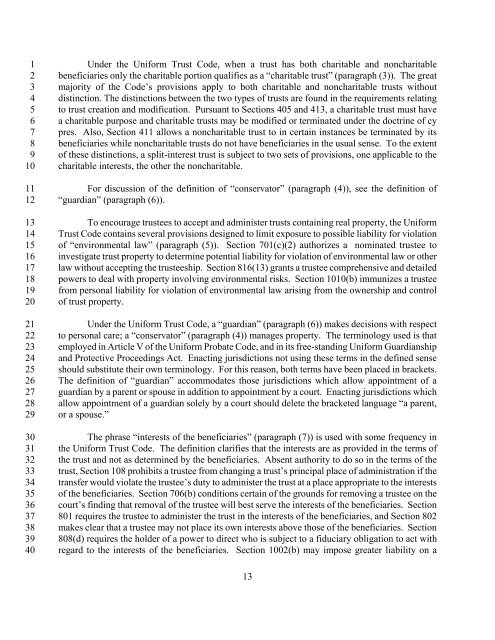uniform trust code - Kansas Judicial Branch
uniform trust code - Kansas Judicial Branch
uniform trust code - Kansas Judicial Branch
You also want an ePaper? Increase the reach of your titles
YUMPU automatically turns print PDFs into web optimized ePapers that Google loves.
1<br />
2<br />
3<br />
4<br />
5<br />
6<br />
7<br />
8<br />
9<br />
10<br />
11<br />
12<br />
13<br />
14<br />
15<br />
16<br />
17<br />
18<br />
19<br />
20<br />
21<br />
22<br />
23<br />
24<br />
25<br />
26<br />
27<br />
28<br />
29<br />
30<br />
31<br />
32<br />
33<br />
34<br />
35<br />
36<br />
37<br />
38<br />
39<br />
40<br />
Under the Uniform Trust Code, when a <strong>trust</strong> has both charitable and noncharitable<br />
beneficiaries only the charitable portion qualifies as a “charitable <strong>trust</strong>” (paragraph (3)). The great<br />
majority of the Code’s provisions apply to both charitable and noncharitable <strong>trust</strong>s without<br />
distinction. The distinctions between the two types of <strong>trust</strong>s are found in the requirements relating<br />
to <strong>trust</strong> creation and modification. Pursuant to Sections 405 and 413, a charitable <strong>trust</strong> must have<br />
a charitable purpose and charitable <strong>trust</strong>s may be modified or terminated under the doctrine of cy<br />
pres. Also, Section 411 allows a noncharitable <strong>trust</strong> to in certain instances be terminated by its<br />
beneficiaries while noncharitable <strong>trust</strong>s do not have beneficiaries in the usual sense. To the extent<br />
of these distinctions, a split-interest <strong>trust</strong> is subject to two sets of provisions, one applicable to the<br />
charitable interests, the other the noncharitable.<br />
For discussion of the definition of “conservator” (paragraph (4)), see the definition of<br />
“guardian” (paragraph (6)).<br />
To encourage <strong>trust</strong>ees to accept and administer <strong>trust</strong>s containing real property, the Uniform<br />
Trust Code contains several provisions designed to limit exposure to possible liability for violation<br />
of “environmental law” (paragraph (5)). Section 701(c)(2) authorizes a nominated <strong>trust</strong>ee to<br />
investigate <strong>trust</strong> property to determine potential liability for violation of environmental law or other<br />
law without accepting the <strong>trust</strong>eeship. Section 816(13) grants a <strong>trust</strong>ee comprehensive and detailed<br />
powers to deal with property involving environmental risks. Section 1010(b) immunizes a <strong>trust</strong>ee<br />
from personal liability for violation of environmental law arising from the ownership and control<br />
of <strong>trust</strong> property.<br />
Under the Uniform Trust Code, a “guardian” (paragraph (6)) makes decisions with respect<br />
to personal care; a “conservator” (paragraph (4)) manages property. The terminology used is that<br />
employed in Article V of the Uniform Probate Code, and in its free-standing Uniform Guardianship<br />
and Protective Proceedings Act. Enacting jurisdictions not using these terms in the defined sense<br />
should substitute their own terminology. For this reason, both terms have been placed in brackets.<br />
The definition of “guardian” accommodates those jurisdictions which allow appointment of a<br />
guardian by a parent or spouse in addition to appointment by a court. Enacting jurisdictions which<br />
allow appointment of a guardian solely by a court should delete the bracketed language “a parent,<br />
or a spouse.”<br />
The phrase “interests of the beneficiaries” (paragraph (7)) is used with some frequency in<br />
the Uniform Trust Code. The definition clarifies that the interests are as provided in the terms of<br />
the <strong>trust</strong> and not as determined by the beneficiaries. Absent authority to do so in the terms of the<br />
<strong>trust</strong>, Section 108 prohibits a <strong>trust</strong>ee from changing a <strong>trust</strong>’s principal place of administration if the<br />
transfer would violate the <strong>trust</strong>ee’s duty to administer the <strong>trust</strong> at a place appropriate to the interests<br />
of the beneficiaries. Section 706(b) conditions certain of the grounds for removing a <strong>trust</strong>ee on the<br />
court’s finding that removal of the <strong>trust</strong>ee will best serve the interests of the beneficiaries. Section<br />
801 requires the <strong>trust</strong>ee to administer the <strong>trust</strong> in the interests of the beneficiaries, and Section 802<br />
makes clear that a <strong>trust</strong>ee may not place its own interests above those of the beneficiaries. Section<br />
808(d) requires the holder of a power to direct who is subject to a fiduciary obligation to act with<br />
regard to the interests of the beneficiaries. Section 1002(b) may impose greater liability on a<br />
13

















